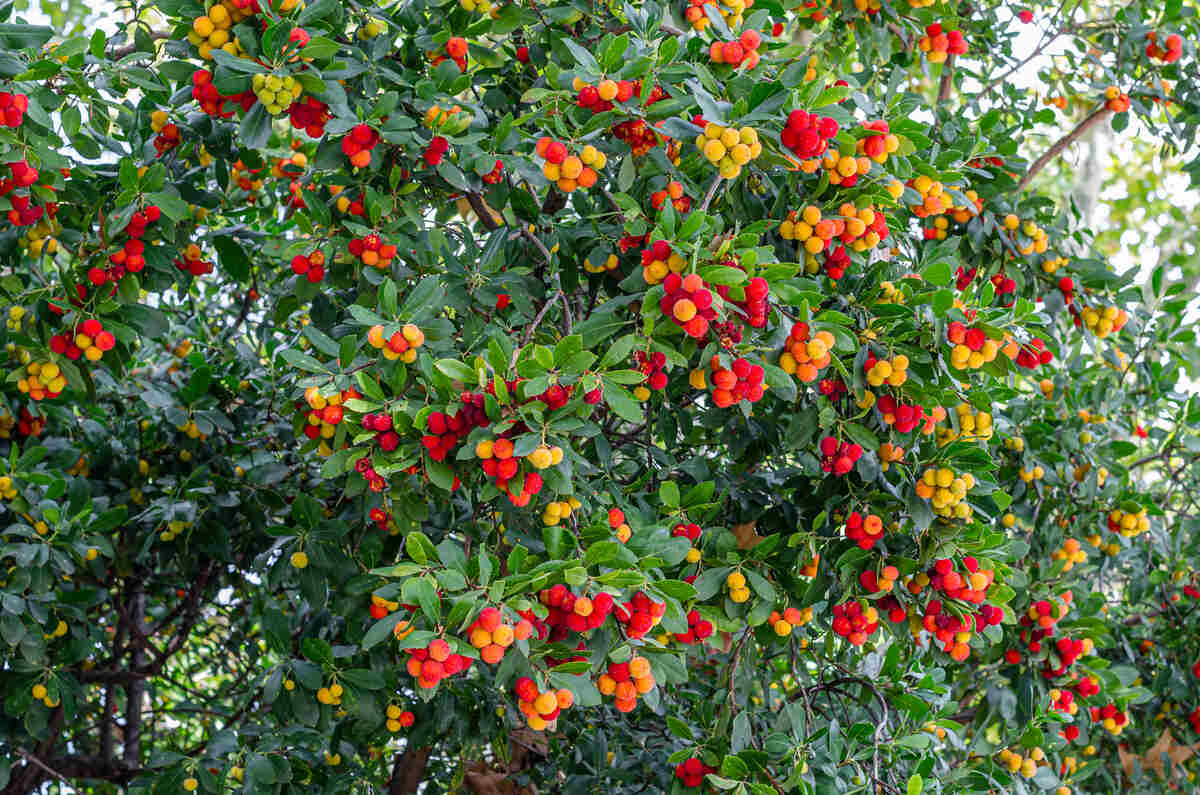
Drought-tolerant trees lose their edge when planted in unsuitable conditions. Choose cold-hardy species like bur oak for the North, heat-tolerant trees like palo verde and mesquite for the Southwest, and resilient trees like Japanese pagoda or Amur maackia for the temperate zone.
This guide features the best drought-resistant trees by region and hardiness zone. Whether you’re gardening in Texas, California, the Midwest or the Northeast, these drought-tolerant trees will thrive in your climate zone.
| To help your trees stay healthy and better withstand drought stress, hire a LawnStarter tree care pro to prune them. Our pros charge an average of $238 per job for light tree pruning. |
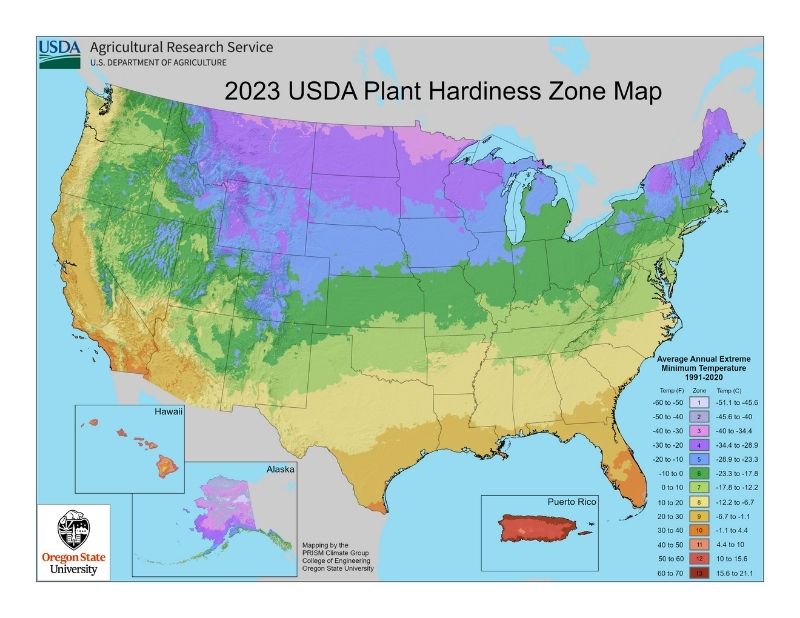
Cold-Hardy Drought-Tolerant Trees (Zones 3-5)
1. Bur Oak (Quercus macrocarpa)
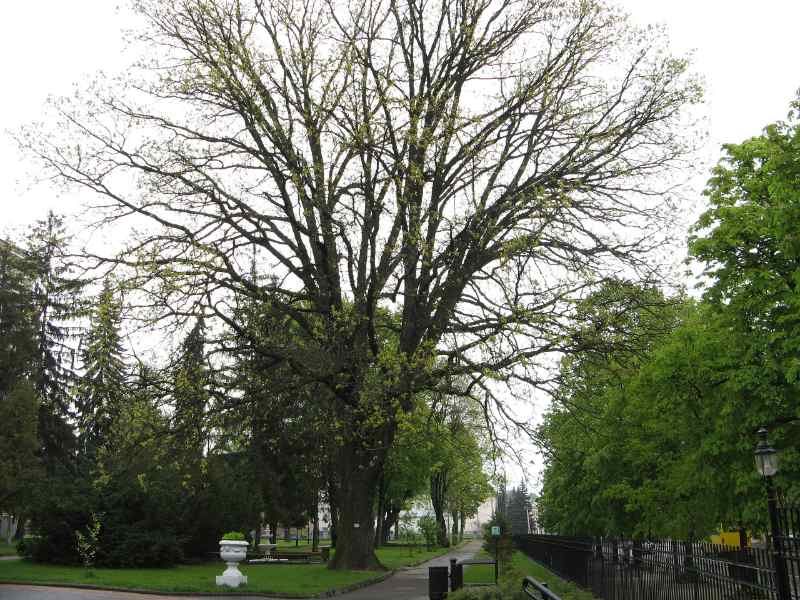
The bur oak is a champion of shade and resilience — this massive tree, with a wide, dense canopy, handles brutal northern winters and southern heat waves, surviving on just 15 inches of rain per year. It’s the ideal drought-tolerant shade tree for large backyards and parks.
- Hardiness zones: 3-8
- Growing conditions Full sun. Prefers well-drained soils. Tolerates compacted, poor soil.
- Foliage: Deciduous
- Mature size: 50-80 feet tall, 40-60 feet wide
2. Kentucky Coffeetree (Gymnocladus dioicus)
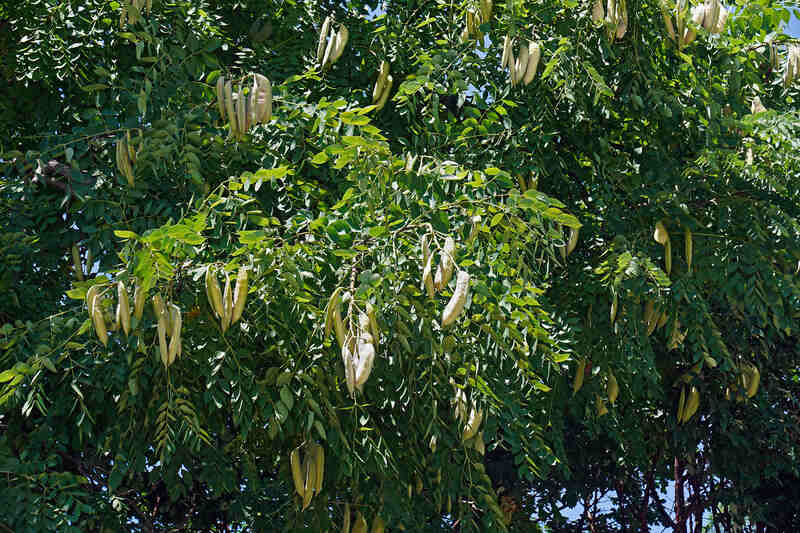
Unlike bur oak, the shade Kentucky coffeetree casts is light and airy, allowing shade-tolerant ground covers to grow underneath. This climate-resilient tree excels in urban landscaping due to its ability to tolerate poor soil, air pollution, and heat.
- Hardiness zones: 3-8
- Growing conditions: Full sun. Well-drained, moist sandy loams or silty clays.
- Foliage: Deciduous
- Mature size: 60-75 feet high, 40-50 feet wide
3. Hackberry (Celtis occidentalis)
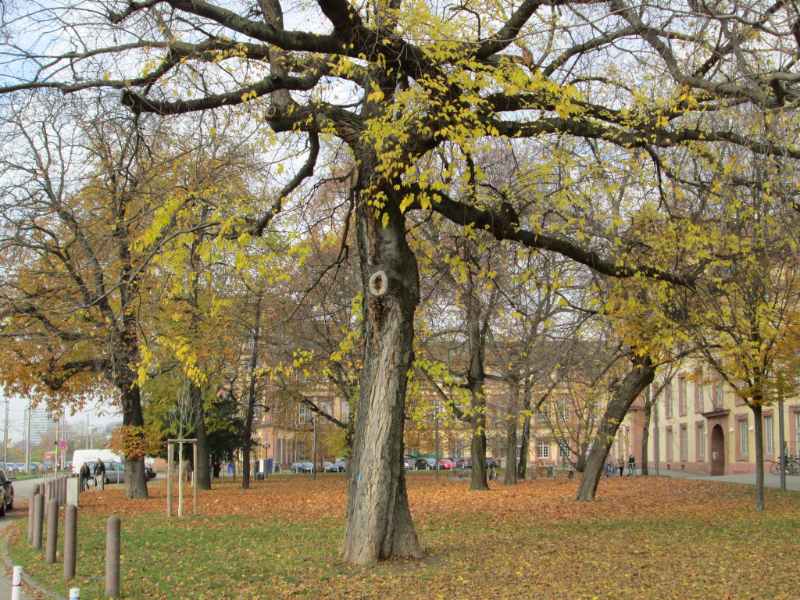
Native to 80% of the United States, the hackberry thrives with just 14 inches of rainfall per year and tolerates compacted soil, flooding, salt, wind, and ice. It shelters and feeds over 45 species of caterpillars and 25 species of birds, making it a smart pick for wildlife habitat certification.
- Hardiness zones: 2-9
- Growing conditions: Full sun to part shade. Prefers well-drained, alkaline soil. Tolerates drought and flooding.
- Foliage: Deciduous
- Mature size: 40-60 feet tall and wide
4. Honeylocust (Gleditsia triacanthos var. inermis)
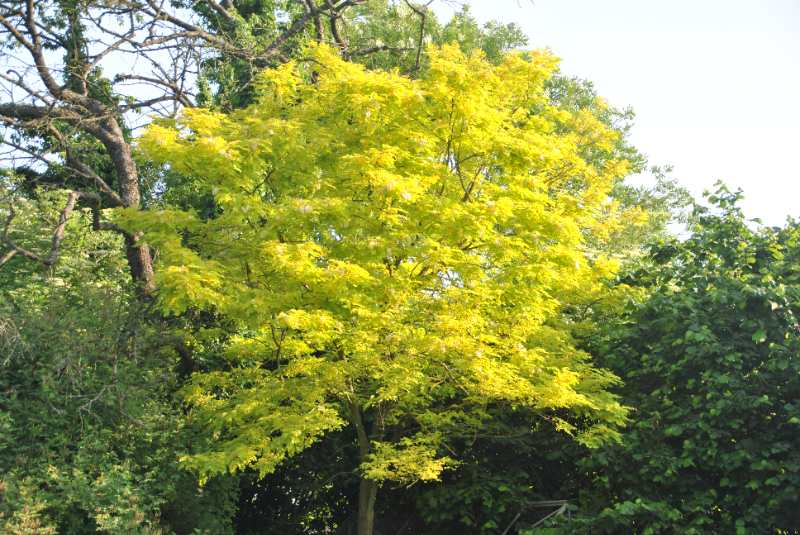
Honeylocust is a cold-hardy, fast-growing shade tree that gains 2 feet annually and can withstand harsh winter cold down to -30 F. Out on the Great Plains, this wind-resistant tree makes an excellent windbreak, standing firm when storms roll through.
- Hardiness zones: 3-10
- Growing conditions: Full sun. Moist, well-drained soil. Tolerates poor and compacted soils.
- Foliage: Deciduous
- Mature size: 40-70 feet high, 30-50 feet wide
Temperate Zone Drought-Tolerant Trees (Zones 6-8)
1. Japanese Pagoda Tree (Sophora japonica)
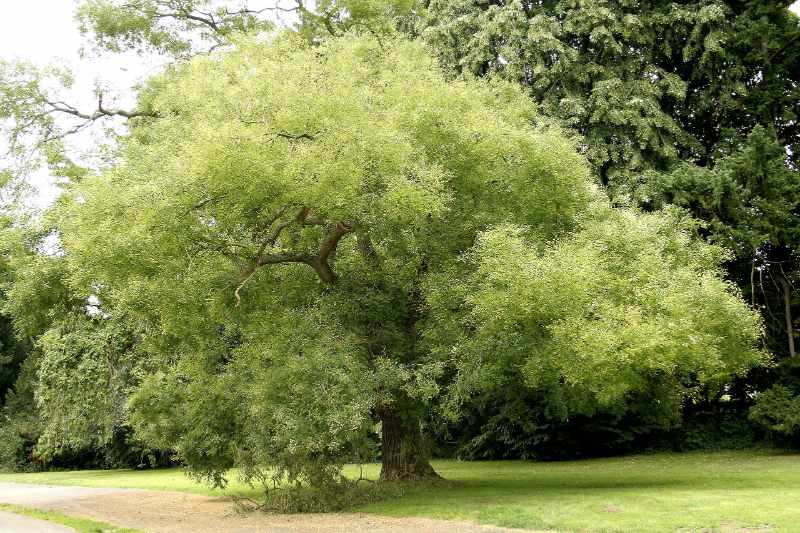
This drought- and disease-resistant tree is a gorgeous bee magnet I recommend for bee-friendly lawns and pollinator gardens. At the end of the season, when many trees and flowers wilt and fade, Japanese pagoda trees bloom with fragrant white flowers, providing late-season pollen for hungry bees and insects.
- Hardiness zones: 4-8
- Growing conditions: Full sun. Well-drained soil, rich in organic matter. Tolerates poor and compacted soil.
- Foliage: Deciduous
- Mature size: 50-75 feet high and wide
2. Chinese Pistache (Pistacia chinensis)
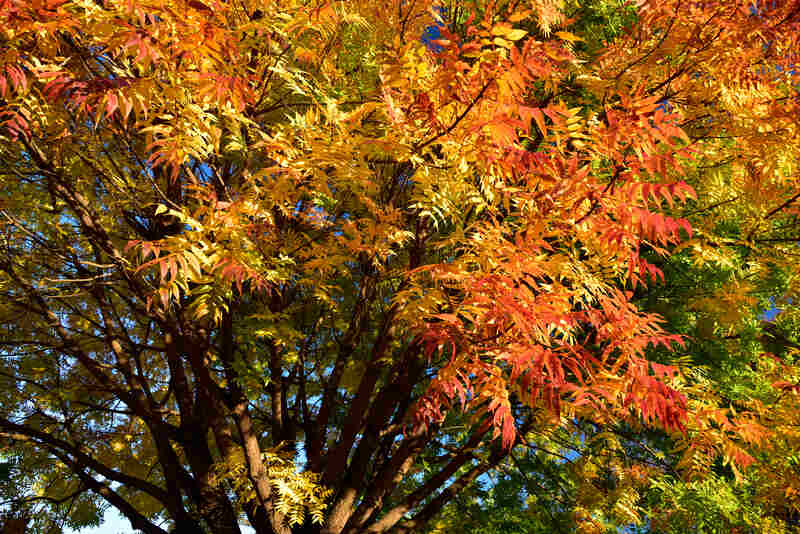
With its medium size and moderate growth rate, which make it ideal for home landscapes, the Chinese pistache is far from average. This tough, drought-tolerant, and pest-free tree can adapt to a variety of conditions, from temperate to tropical zones, lighting up yards with fiery-red fall color — a perfect fit for xeriscaping and shade gardens alike.
- Hardiness zones: 6-9
- Growing conditions: Full sun. Moist, well-draining soil.
- Foliage: Deciduous
- Mature size: 30-35 feet high, 20-30 feet wide
3. Crape Myrtle (Lagerstroemia indica)
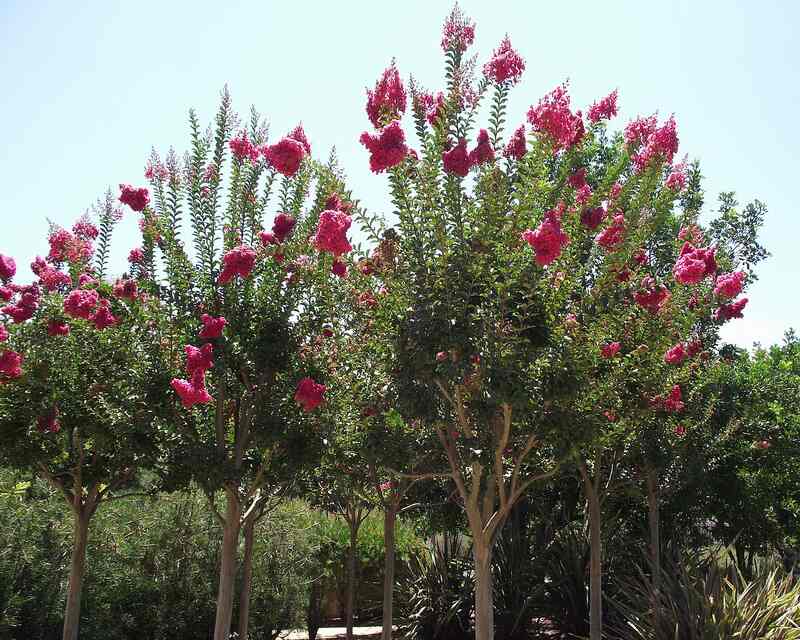
For maximum visual impact with minimal water needs, choose crape myrtle. This gorgeous flowering tree delivers year-round beauty with vibrant blooms in the summer, orange-to-purple leaves in the fall, and a tan to cinnamon exfoliating bark that reveals itself in the winter.
- Hardiness zones: 7-9
- Growing conditions: Full sun. Moist, well-drained, slightly acidic soil.
- Foliage: Deciduous
- Mature size: 6-30 feet high and wide
4. Amur Maackia (Maackia amurensis)
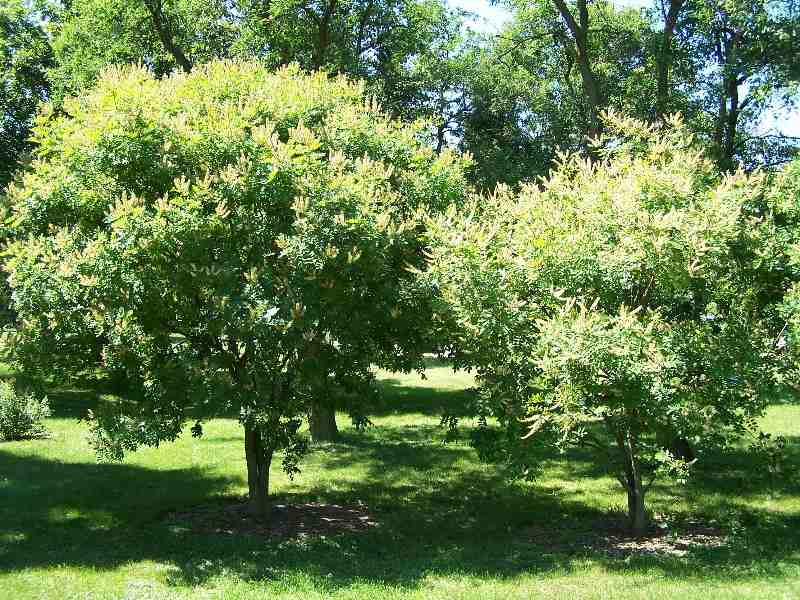
Seattle’s urban forestry program describes Amur maackia as a “small, tough, and urban-tolerant tree.” This compact powerhouse suits modern landscapes where space is limited but drought tolerance is essential. Cold-hardy and nitrogen-fixing, it enriches poor soil for more sensitive species.
- Hardiness zones: 3-7
- Growing conditions: Full sun to partial shade. Well-drained, average moisture.
- Foliage: Deciduous
- Mature size: 20-30 feet high and wide (in cultivation)
Western and Southwestern Drought-Tolerant Trees (Zones 8-11)
1. Olive Tree (Olea europaea)
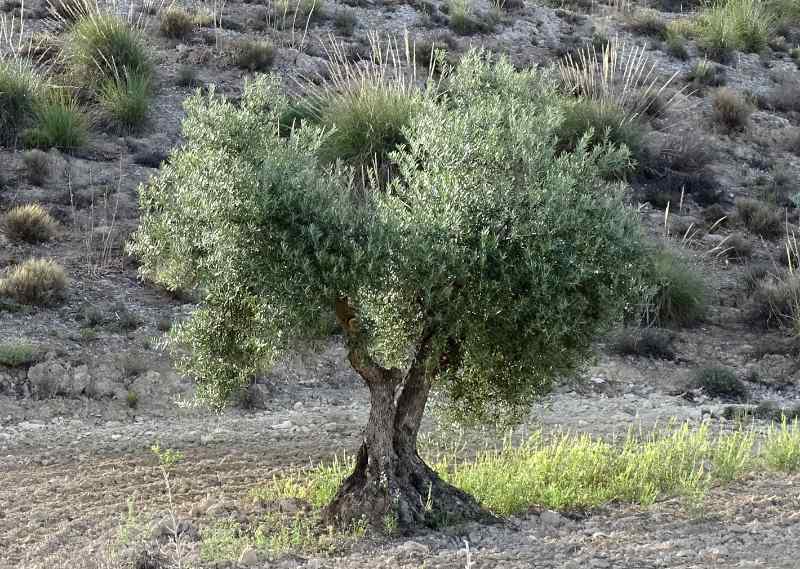
I’ve noticed an increased trend towards Mediterranean-style landscaping in drought-prone areas, and the olive tree fits right in. These drought-tolerant fruit trees showcase an elegant, sculptured trunk, silvery-green foliage, fragrant flowers, and produce tasty olives perfect for marinating.
- Hardiness zones: 8-10
- Growing conditions: Full sun. Well-drained soil. Tolerates poor, rocky, and alkaline soils.
- Foliage: Evergreen
- Mature size: 20-30 feet high and wide
2. Palo Verde (Parkinsonia spp.)
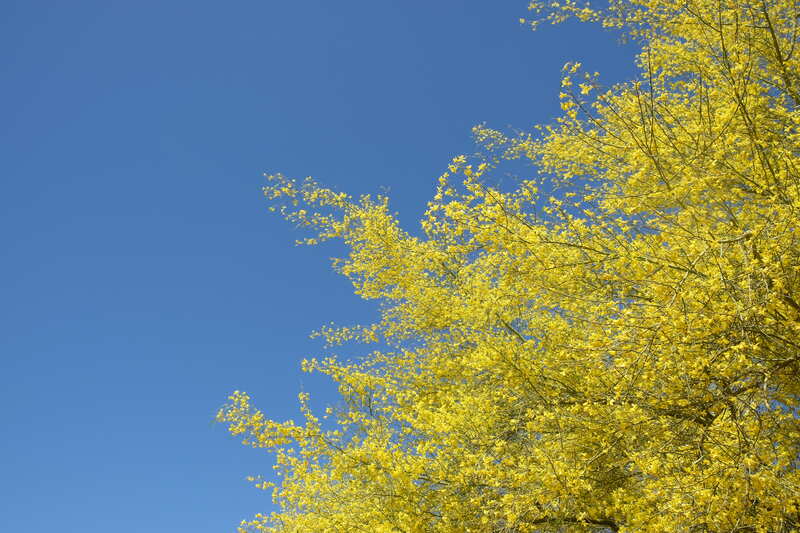
Palo verde is the Superman of small desert trees. Native to the Sonoran desert, it tolerates scorching temperatures above 100 F and thrives with just 3 to 20 inches of water per year. Its secret power? Palo verde limits water loss by shading its leaves and uses its chlorophyll-rich green bark for photosynthesis.
- Hardiness zones: 8-11
- Growing conditions: Full sun. Well-drained soil. Tolerates poor, alkaline, and sandy soil.
- Foliage: Deciduous.
- Mature size: 10-50 feet high, 20-30 feet wide.
3. Texas Ebony (Ebenopsis ebano)

Texas ebony’s dense, rounded crown makes it a great shade tree for resting areas like patios or decks. Pair it with drought-tolerant grasses and flowering plants for a water-wise landscape, but keep it away from swimming pools — it drops seedheads and pollen.
- Hardiness zones: 8-11
- Growing conditions: Full sun to partial sun. Tolerates a wide range of soil conditions.
- Foliage: Evergreen
- Mature size: 30 feet tall and wide
4. Desert Willow (Chilopsis linearis)
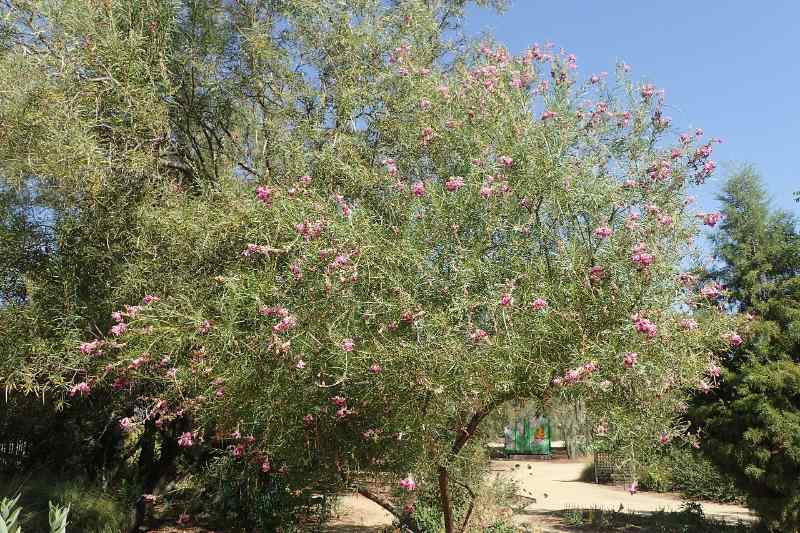
The Arbor Day Foundation calls it “the tree that blooms in drought.” When other plants wilt under the summer heat, this drought-resistant tree blooms pink orchid-like flowers, making it one of the best xeriscaping plants for colorful gardens.
- Hardiness zones: 7-11
- Growing conditions: Full sun. Prefers well-draining soil, neutral to alkaline.
- Foliage: Deciduous.
- Mature size: 15-30 feet tall, 15-25 feet wide
| To ensure your trees grow healthy and drought-resilient, hire a LawnStarter tree care pro to plant them. Our pros charge, on average, $180 per job to plant shrubs and small trees. |
5. Mesquite (Prosopis spp.)
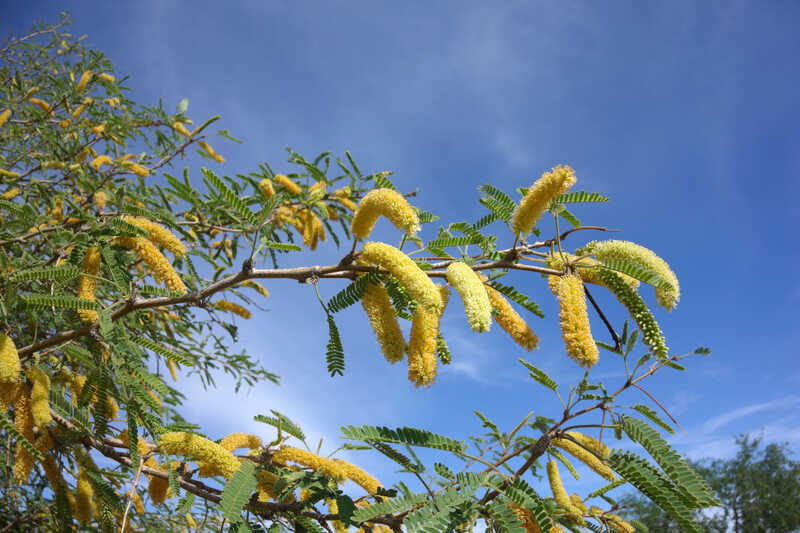
Mesquites boast massive root systems that conquer drought, spreading 50 feet wide in central Texas or diving deep into the Sonoran desert soil to tap underground water. These drought-tolerant trees stabilize soil and provide habitat and food for wildlife in harsh, arid locations.
- Hardiness zones: 6-11
- Growing conditions: Full sun. Well-drained soil.
- Foliage: Deciduous
- Mature size: 20-30 feet tall, and 30 feet wide
6. Cork Oak (Quercus suber)
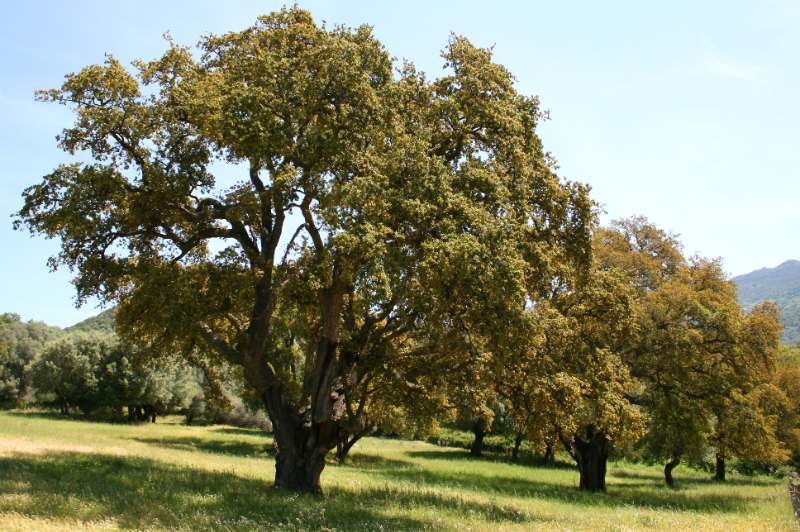
Salt-tolerant, drought-resistant, and able to withstand up to 104 F, the cork oak is an ideal landscape tree for the southwestern United States and the coastal climate zones. Its thick bark provides fire protection and regenerates if peeled off, trapping huge amounts of carbon dioxide in the process.
- Hardiness zones: 7-10
- Growing conditions: Full sun. Acidic, dry to medium, well-drained soil.
- Foliage: Evergreen
- Mature size: 70-100 feet tall and wide
7. Manzanita (Arctostaphylos spp.)
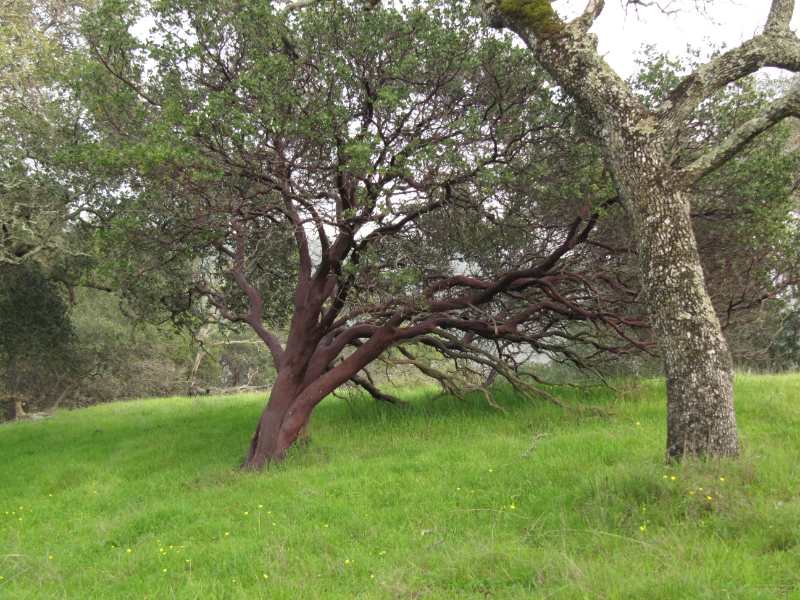
This tree’s pest control method is mind-blowing. Every summer, it sheds the old bark (infested or not) and transforms into a work of art, revealing smooth, sculpted trunks ranging from rich mahogany and orange to red, maroon, and nearly black. Place it among drought-tolerant shrubs to create eye-catching contrasts.
- Hardiness zones: 7-10
- Growing conditions: Full sun to part sun. Well-drained, infertile soil.
- Foliage: Evergreen
- Mature size: Up to 20 feet tall and 10 feet wide
8. California Pepper Tree (Schinus molle)
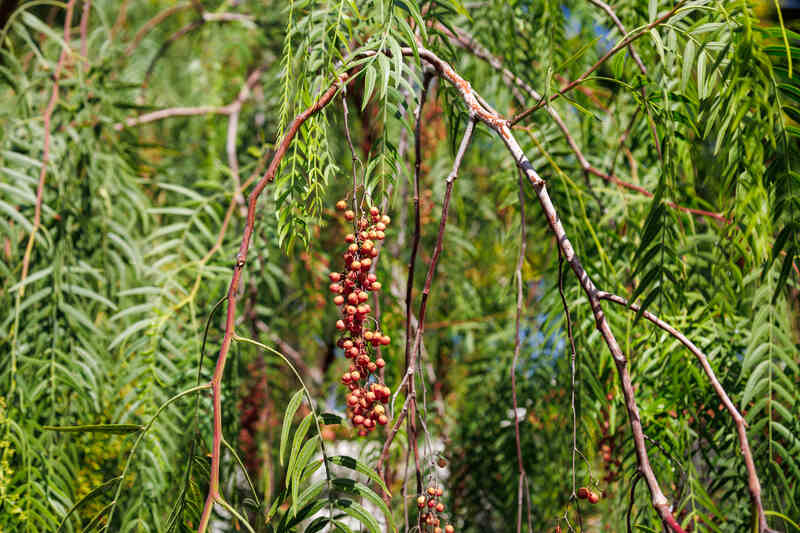
Native to dry South American regions, the California pepper tree knows how to handle drought. Its deep roots find groundwater while its narrow, feathery leaves conserve moisture. This drought-tolerant perennial works well as a centerpiece and privacy screen.
- Hardiness zones: 8-11
- Growing conditions: Full sun to part shade. Well-draining soil.
- Foliage: Evergreen
- Mature size: 25-40 feet tall and wide
9. Coast Live Oak (Quercus agrifolia)
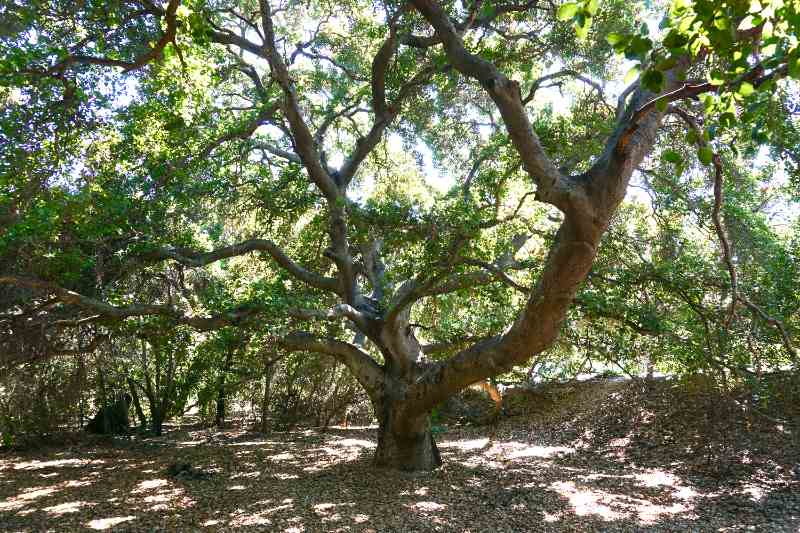
Standing out as the only native oak that thrives near the ocean, this majestic tree is not only drought-hardy and salt-tolerant, but it creates its own bustling ecosystem. Over 270 species rely on the coast live oak for shelter and acorns, while its fallen leaves enrich the soil (making tree fertilizers unnecessary).
- Hardiness zones: 9-11
- Growing conditions: Full sun to partial shade. Prefers deep, well-draining loam.
- Foliage: Evergreen
- Mature size: 30-80 feet high and wide
10. Sweet Acacia (Vachellia farnesiana)
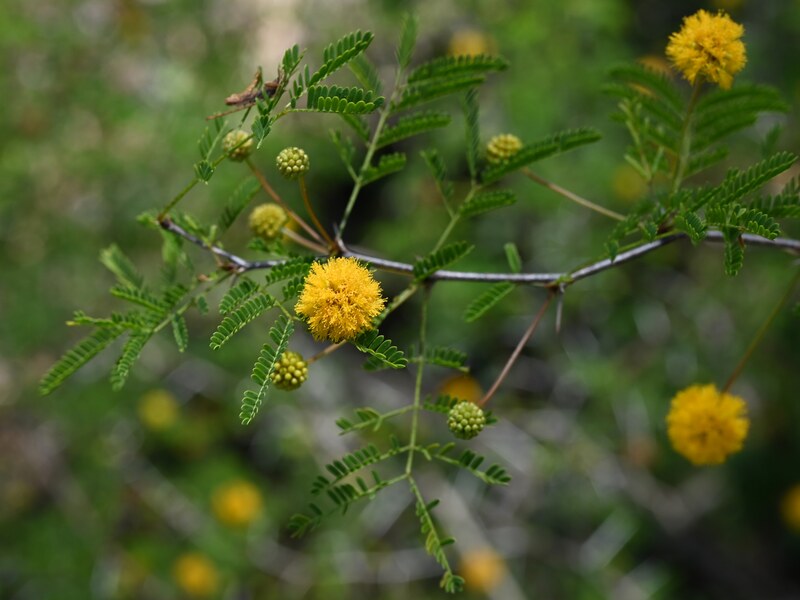
Sweet acacia is tough enough to thrive in the sandy soils of the Southwestern deserts and perfect for sensory gardens aiming to conserve water. Late winter to early spring, its canopy fills with golden, puffball-like flowers that release a warm, honey fragrance and attract joyful songbirds.
- Hardiness zones: 9-11
- Growing conditions: Full sun. Well-draining, dry to moist, sandy, loamy, or calcareous soil.
- Foliage: Semi-evergreen
- Mature size: 8-15 feet high, 5-10 feet wide
11. Strawberry Tree (Arbutus unedo)
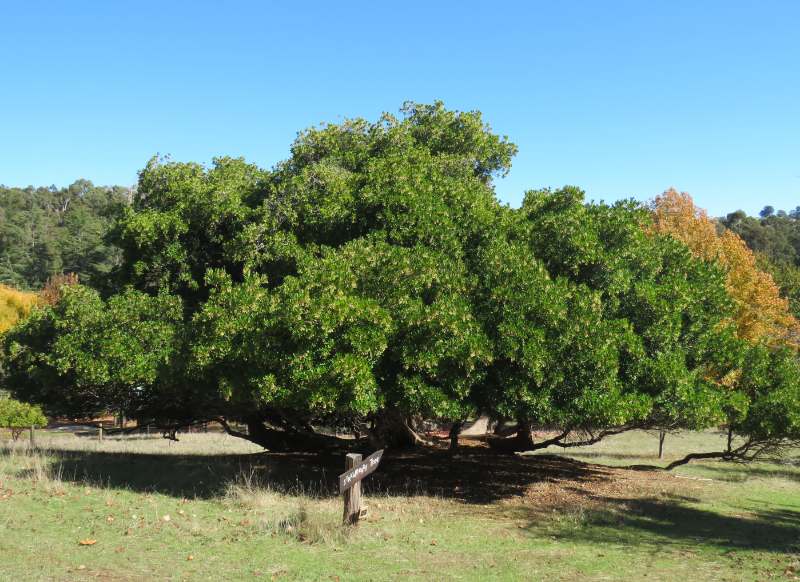
Increasingly popular on the West Coast and warm southern regions, this evergreen tolerates drought, salt, and poor soil and is a four-season delight. With persistent leaves, white bell-shaped fall flowers and small edible berries (sweet when reddish), it adds vibrant colors to both coastal and inland gardens.
- Hardiness zones: 7-10
- Growing conditions: Full sun to partial shade. Well-drained sandy, loamy to clay soils
- Foliage: Evergreen
- Mature size: 13-23 feet high, 5-20 feet wide
12. Blue Palo Verde (Parkinsonia florida)
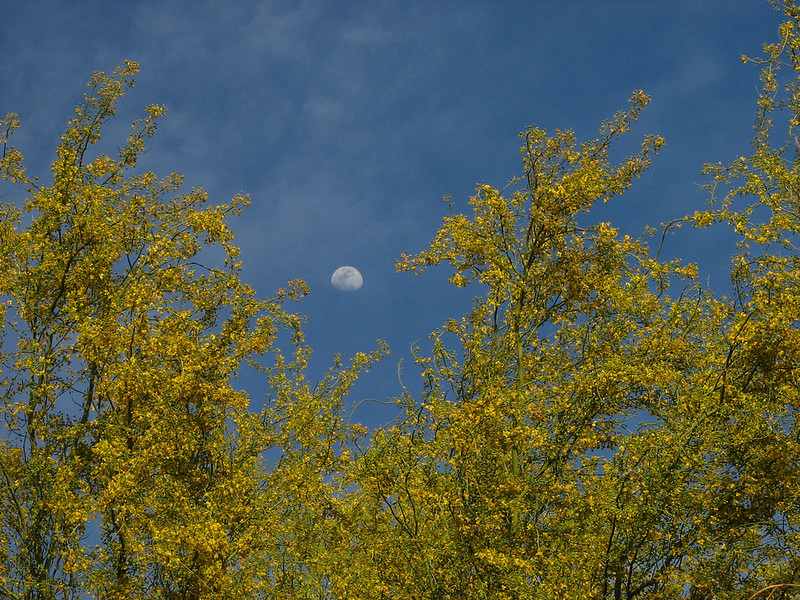
Less drought-tolerant than foothill palo verde (Parkinsonia microphylla), but still fit for low-water landscapes, blue palo verde is more suitable for planting near lawns and other irrigated areas. Enjoy its prolific yellow flowers in spring (and sometimes in fall), but avoid overwatering and ensure the soil has good drainage.
- Hardiness zones: 8-10
- Growing conditions: Full sun and reflected heat. Well-drained soil.
- Foliage: Deciduous
- Mature size: 20-30 feet high, 20-25 feet wide
FAQ
To establish drought-tolerant trees:
• Plant in fall for best root development
• Water 2-3 times weekly during the first year (otherwise they’ll show signs of drought stress), then reduce frequency gradually
• Apply 2 to 4 inches of mulch over the root zone
Most drought-tolerant trees need at least 2-3 years to establish and thrive without additional watering.
Sweet acacia (8-20 feet), desert willow (15-30 feet), and Amur maakia (20-30 feet) are ideal drought-tolerant trees for compact spaces.
Need Help Selecting the Right Tree?
Choosing the right drought-tolerant trees for your climate and yard size can be challenging, but don’t get discouraged. Find a landscaping expert with LawnStarter and start creating your perfect water-wise garden this season.
Read More:
Sources:
- “Amur Maackia.” Seattle.gov.
- “Desert-Willow: The Tree That Blooms in Drought.” The Arbor Day Foundation.
- “Mesquite Ecology.” By researchers James Ansley, J.A. Huddle, and Betty Kramp. Texas Agricultural Experiment Station, Vernon, TX.
- “Quercus suber.” Oregon State University.
- “Coast Live Oak (Quercus agrifolia).” Calscape California Native Plant Society.
- “Plant Finder.” Missouri Botanical Garden.
- “Plant Database.” The National Gardening Association.
- “Sweet Acacia.” Florida Wildflower Foundation.
- “Treesearch.” Forest Service, U.S. Department of Agriculture.
Main Image Credit: Strawberry Tree / vli86 / Adobe Stock